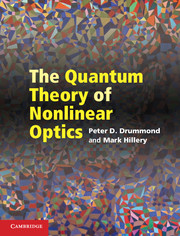Book contents
- Frontmatter
- Contents
- Preface
- Introduction
- 1 Classical nonlinear optics
- 2 Field quantization
- 3 Quantized fields in dielectric media
- 4 Microscopic description of media
- 5 Coherence and quantum dynamics in simple systems
- 6 Decoherence and reservoirs
- 7 Phase-space distributions
- 8 Single-mode devices
- 9 Degenerate parametric oscillator
- 10 Quantum field dynamics
- 11 Quantum propagation in fibers and waveguides
- 12 Quantum information
- List of symbols
- Index
- References
1 - Classical nonlinear optics
Published online by Cambridge University Press: 05 May 2014
- Frontmatter
- Contents
- Preface
- Introduction
- 1 Classical nonlinear optics
- 2 Field quantization
- 3 Quantized fields in dielectric media
- 4 Microscopic description of media
- 5 Coherence and quantum dynamics in simple systems
- 6 Decoherence and reservoirs
- 7 Phase-space distributions
- 8 Single-mode devices
- 9 Degenerate parametric oscillator
- 10 Quantum field dynamics
- 11 Quantum propagation in fibers and waveguides
- 12 Quantum information
- List of symbols
- Index
- References
Summary
Before discussing nonlinear optics with quantized fields, it is useful to have a look at what happens with classical electromagnetic fields in nonlinear dielectric media. The theory of nonlinear optics was originally developed using classical fields by Armstrong, Bloembergen, Ducuing and Pershan in 1962, stimulated by an experiment by Franken, Hill, Peters and Weinreich in which a second harmonic of a laser field was produced by shining the laser into a crystal. This classical theory is sufficient for many applications. For the most part, quantized fields were introduced later, although a quantum theory for the parametric amplifier, a nonlinear device in which three modes are coupled, was developed by Louisell, Yariv and Siegman as early as 1961. In any case, a study of the classical theory will give us an idea of some of the effects to look for when we formulate the more complicated quantum theory.
What we will present here is a very short introduction to the subject. Our intent is to use the classical theory to present some of the basic concepts and methods of nonlinear optics. Further information can be found in the list of additional reading at the end of the chapter. The discussion here is based primarily on the presentations in the books by N. Bloembergen and by R. W. Boyd.
Linear polarizability
We wish to survey some of the effects caused by the linear polarizability of a dielectric medium. When an electric field E(r, t) is applied to a dielectric medium, a polarization, that is, a dipole moment per unit volume, is created in the medium.
- Type
- Chapter
- Information
- The Quantum Theory of Nonlinear Optics , pp. 4 - 36Publisher: Cambridge University PressPrint publication year: 2014



